Common mistakes people make when using social listening tools

Summary
Social listening can prove complicated to make use of. While there can be myriad reasons for that, it is very possible you just haven’t gotten through some of the initial hurdles. To speed you along and help you get the most out of Awario, we aim to address the most frequently encountered issues with social listening in this article.
21-minute read
There can be no denying that finding just the tool for your current project is exciting, especially considering the variety of digital marketing solutions available today. At that point, all one thinks about is diving straight in, with manuals, guides, and meticulous setup put aside. What could go wrong, right? Next thing you know, the tool doesn’t work in the way you’ve imagined, all of the results are off the mark, and you have no idea how to proceed from there.
Social listening tools like Awario are no exception. Often enough, we see people sign up, create a couple of seemingly random searches, and then be disappointed in the results they get. The issues can be rather varied — from wide and conceptual to very grounded and tool-specific. For this reason, we’d like to offer marketers a helping hand by addressing some of the most common mistakes we see them do while trying out Awario.
Lacking a plan
We’ve observed that more than a few hurdles our users run into while trying out Awario point to a bigger issue — a lack of clarity on what the users want to achieve. Social listening tools shine the most whenever the searches are constructed with a clear purpose in mind. Therefore, having an established goal before committing resources for social listening is imperative for success.
While we can’t go over all possible uses in detail, we can offer 3 points to ponder before you charge in. They should help you understand the potential impact social listening can have on your project.
By signing up I agree to the Terms of Use and Privacy Policy
1. What are you hoping to find?
Tools like Awario boast a variety of applications, so it is best to identify which ones make the most sense for your case and focus on them. Otherwise, you risk having to waste time and energy sifting through a sea of patchy mentions that might not hold much value.
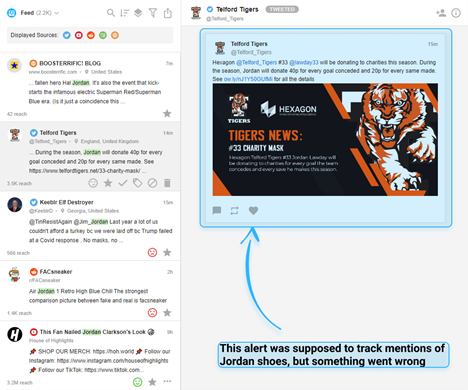
Let’s say you’re an upstarting business in the process of forming a social media strategy. In that scenario, using social listening to monitor your performance on various platforms might not make sense since finding anything of value is unlikely at that stage. Instead, it might benefit you more to focus on tracking your more established competitors or even the industry at large.
This way, you might be able to glean valuable insights from competitors’ social media performance, see what works and what doesn’t, and apply that knowledge to your strategy. Alternatively, you may choose to cast a wider eye over your chosen industry to try and see what is going on now and what is to follow. In this case, the data discovered can enable you to jump your competitors by incorporating the newest trends into your strategy more quicker.
2. What is the best way of finding the right data?
Once you’ve decided on the what, it is time to jump to the how. Social listening operates on a keyword search basis, so a mention would be captured whenever the keywords you’ve entered are used somewhere. While the keywords are not the only thing going into the creation of a search, they are the base building block. Simply put, poor choice of keywords equals poor results.
While there might not be a one-size-fits-all recipe for choosing the right keywords, there are some principles that apply regardless of your use case. For instance, let’s say you want to find mentions where people discuss and compare Apple to Samsung. Your initial setup will look somewhat like this:

This sample search has two major issues:
-
the keywords are not actually connected, meaning that this search will be looking for disjointed mentions of either company, but not necessarily both in one post;
-
the Apple keyword will bring mentions of both the tech giant and the myriad other contexts it is used in. In the end, this initial query will fail to bring us the relevant data.
So how do we fix it?
In this particular case, the key to solving both issues is in connecting the Apple and Samsung keywords. This can be done via a Boolean query, which will look like the following:
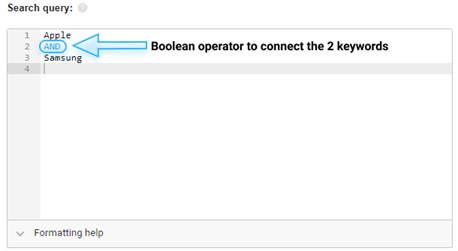
This way, our search will only find mentions where both companies appear. At the same time, the Apple keyword is unlikely to be in any other context when mentioned alongside Samsung. While not completely foolproof, this alert has a much higher chance of bringing the results we set out to obtain.
After connecting the keywords, the next step to elevate this search would be to add possible variations people might use when referencing both Apple and Samsung. For example, some may use specific handles, hashtags, or maybe a certain jargon to reference the companies. It would be wise to include as many options as you’re aware of:

Knowing what to find is only half of the trouble. Exploring the methods to find the right data is the other, no less important half. Arriving at a perfect search query takes planning, vocabulary exploration as well as some trial & error. But once you grasp the logic behind social media mentions, you’ll be able to foresee the potential issues with your queries and adjust them straight away.
3. What is the time frame?
Another point to keep in mind during the planning phase is the time constraints you have to follow. Generally speaking, social listening works best over a longer stint where you allow it breathing space.
While some data will surely be found within minutes of the search’s inception, it will be incomplete and therefore inconclusive. As such, social listening tools might not be the best solution if you need to generate a monthly activity report and have only a couple of hours until the deadline. If, however, you’ve set up your searches prior to the D-day (say, two weeks), you can expect to get much more accurate reporting on your searches.
The last variable in the time equation we’d like to bring up is how long it’ll take to set up a proper search query for your topic. Picking up the relevant information from the hectic sea of social media data can prove challenging, even if your case doesn’t seem all that complicated. For that reason, it is best to factor a bit of time into exploring the settings.
The three points we just covered should help you form a plan on how a social listening solution might work within your project. It is important to remember that tools like Awario are ultimately just that — tools. From a high-level perspective, the key to success with social listening lies with your abilities — interpreting the data, seeing patterns, and brainstorming.
Balancing quality and quantity
On a more grounded level, good social listening is a fine balancing act between being as laser-focused in your searches as possible while avoiding being laser-focused so much that you hardly find anything. Achieving this level of precision will take time, effort, and a couple of iterations on your search settings. To help you balance your searches and find relevant results as quickly as possible, let’s discuss the two extreme ends of the balancing spectrum.
Being too general
When setting up a search query, often enough, you’d put in a few wide keywords around your topic and stop there to see what will be brought. After all, the specific mentions you’re interested in should be bundled up with other results as well, so you’ll just need to go through the bunch a little bit, right?
While this logic has its merits, one thing to keep in mind is that every social listening tool has a monthly quota (yes, even Awario!). Therefore, being too general with your search settings entails paying for mentions you don’t want — both with the money and the time it takes to sift through them. Not to mention that trying to filter out the irrelevant noise your general query has collected often proves too daunting a task.
So how do you avoid being too general? Just have a plan fleshed out before setting up a search, and the right keyword ideas will pop into your mind’s eye before long.
Let’s say you’re Spotify and the only mentions you actually care to find are negative in nature — complaints, bad experiences, and such. In this case, all you need to do is combine the brand name and its possible variations with words people would use to talk of their negative experience — “awful”, “unfair”, “terrible”, etc. At the same time, it is important to try and exclude as much irrelevant content as possible. Here’s how such a query would look like in Awario:

And here are some of the results you can expect this query to bring:

This sample query can be refined even further with the same basic principle of appending the relevant words via the Boolean search mode. Luckily, you can add as many words as you’d like there, so feel free to go wild and explore!
Being too restrictive
While slightly less common, this other side of the balance coin can be equally as harmful to your social listening experience. In the context of social listening, being too restrictive means being extremely specific with your wording and failing to consider how others might refer to the topic you’re trying to monitor. This is easily avoided by adding variations of your keywords — alternative names, common misspellings, social media handles, synonyms, etc.
Let’s say you are M&M's, and you’re keen on learning more about the brand conversations going online. Using the proper spelling alone will miss us a lot of potentially relevant mentions, so it’s a good idea to add as many misspellings as possible. In addition, using their social media handle and the official website link as keywords is a good idea as well:
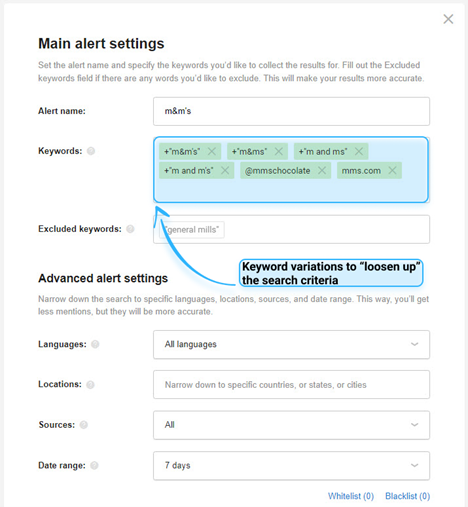
With these settings, we’ll be able to capture as many relevant conversations as there are in the span of the last seven days.
To recap: in the majority of cases, broad keywords just flood you with irrelevant noise, while excessive precision prevents you from finding much at all. Choosing the right keywords for your project involves probing the two extremes until you deem the results your search collects just right.
By signing up I agree to the Terms of Use and Privacy Policy
It should be noted, however, that broad and excessively precise keywords have their merit and can be effective in specific scenarios. Casting your net wide into the social media sea can help you get a better grip on how your topic is discussed online. This knowledge can then enable you to hone in on the specific aspects you’re looking for, getting you closer to a perfect search. At the same time, being stiff with restrictions can be relevant if you’re looking to find data on some very specific aspects of a given issue or topic.
Getting mired in the basics
A lot of the time we see our users being content with doing simple social media monitoring and occasionally replying to some of the mentions. And that’s okay if your objective is to just keep a pulse on brand-relevant conversations. Still, social listening can be so much more than simple monitoring. Let’s have a brisk rundown of some applications that fly under the radar:
Lead generation
Nowadays, it wouldn’t be an exaggeration to state that social media is a medium of choice for all manner of conversations. This is why it is unwise to ignore socials when you’re on the hunt for prospects.
If done manually, social selling can prove a tedious venture. So to make the right threads easier to unearth and follow, Awario has designed a dedicated module aptly dubbed Leads. This part of our tool is made to be on the lookout for conversations where people are asking for recommendations on a product or service just like yours.
All you need to do to get started with this module is capture the essence of your product/service in a few short phrases, optionally add some competitor names and adjust other parameters, and then just wait for the first results to come in.
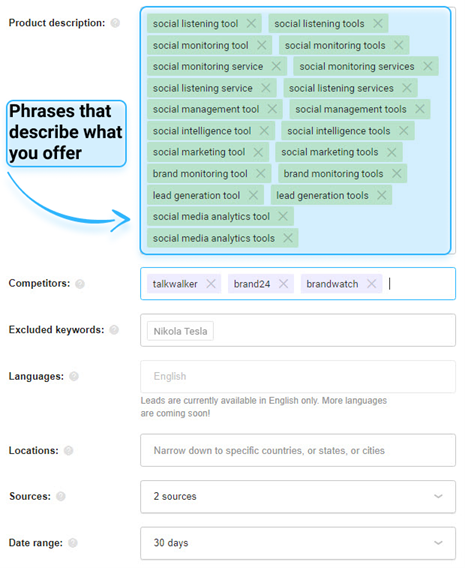
Awario will aim to discover conversations where people are already primed to talk about solutions. So all that remains is to approach them and tactfully offer yours.
Here are a few sample posts that should give you an idea of what to keep an eye out for:

Influencer discovery
The benefits of influencer marketing hardly need recapping. And in case you have ever tried your hand at it, you can attest to the fact that the hardest part is actually finding the right influencers. The main reason for that is the abundance of elements that go into defining the perfect candidate, and it's not just their follower base — it’s their fluency in your niche, their interest in your brand, how your brand images align, your budget, and more.
This is why there are tools to streamline the search process. Awario’s main objective might be finding mentions according to your search parameters and providing analytics, but the same principle can be extended to influencer discovery as well. Here’s how you’d go about it:
1. Create an alert with so-called industry keywords — everything related to your niche:
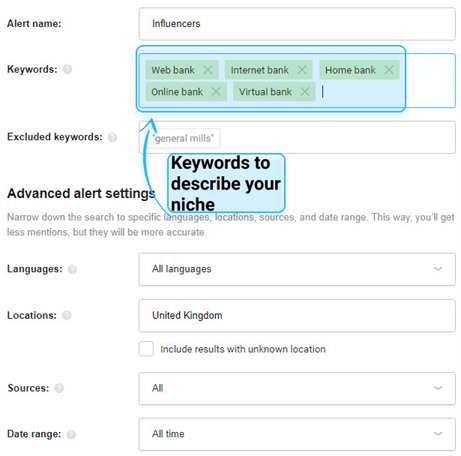
2. Allow the tool to roam the social media landscape for you. After that, head to the Influencers tab in the left panel. You’ll find a list of potential influencers there:

It should be pointed out that, unlike most tools, Awario doesn’t feature any pre-built influencer database. Instead, potential profiles are discovered dynamically through the keywords you’ve put in. The benefit of that method is that the list of influencers our tool generates is never outdated.
The main criteria going into identifying potential influencers are their audience size, the number of mentions they made, and the relative sentiment of their mentions. After all, collaborating with people that have actively discussed your brand/niche before is infinitely easier, not to mention more authentic. Actually reaching out to these influencers and recruiting them to your cause is still up to you, though.
Awario can be equally useful in tracking the performance of influencers you already work with, too. Tracking them will ensure you see their impact on your campaign in terms of how the mention volume, reach, and sentiment have shifted over time of your partnership.
Remembering the analytics
Whenever social listening devolves into simple social media monitoring, the focus shifts to the individual mentions, and the analytics get overlooked. Even if your initial objective doesn’t factor in the need for statistical information, you only stand to gain by having a look at the insights social listening tools like Awario can supply:
-
The volume of mentions — the most baseline of social media statistics, the volume of mentions is not unlike the vital signs monitor for your campaign. Sudden spikes in volume in either direction are something you don’t want to miss;
-
The sentiment statistics — gauging the sentiment over a particular niche is beneficial to any marketing campaign in its formation phase. Additionally, seeing how the sentiment of your topic changes over time helps you assess the effectiveness of your current course;
-
Demographics — knowledge of your audience (like locations, genders, etc.) can be a boon in fine-tuning your content, delivery, and other aspects for current and future campaigns;
-
Topic cloud — especially useful in the exploration phase, the topic cloud helps you see what exactly is being discussed around your topic of interest at this point. Being able to see the overarching narrative from the get-go can save you a lot of time on going through mentions by hand.
Leveraging the power of insights Awario provides you with is the difference between being stuck in a social media monitoring loop and doing the real social listening. Doing so allows you to see the emerging trends in your niche, gain a deeper understanding of conversations going around it, spy on competitors, and much more.
In conclusion
Social listening ventures can fail to strike gold for many reasons. Maybe you were expecting something different, maybe the technology is too confusing, or maybe you just haven’t done your research well enough.
Regardless of the reasons, social listening can be extremely beneficial for any marketer as long as they overcome the initial hoops. And for mercy, doing that is not very hard — all you need is to spend a bit of time brainstorming your plan of attack, just like with any other digital marketing activity.
And in case you still find yourself struggling, our team here at Awario will be glad to assist. Feel free to reach out and sign up for a trial.













